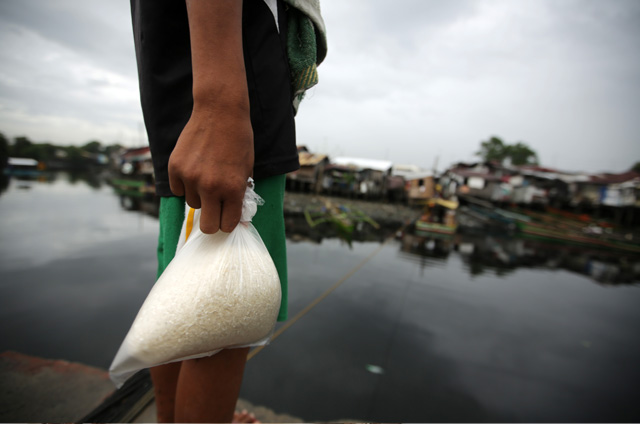SUMMARY
This is AI generated summarization, which may have errors. For context, always refer to the full article.

We were supposed to write about the graft and corruption case filed against Vice President Jejomar Binay because we think that issues like these should be tackled to raise awareness among citizens.
But a comment regarding rice from a group member’s mother got us curious: “Dati P25 ($.56)* lang ang bigas noong maliit pa lang kayo, ngayon mahigit P40 ($.89) na. Mahirap na talaga ang buhay ngayon,” we heard her say. (Rice only cost P25 before, while it’s P40 now. Life is really hard nowadays.)
Being part of a generation in which only select people are aware of the country’s economic status before, we really had no idea that the price of this commodity has almost doubled since then.
Shocked with this information, we started to research regarding the status of agriculture in the Philippines and what brought about this sudden price increase.
We learned that our country has been importing rice since 1869, back when our own national hero Dr Jose Rizal was still 8 years old. Unfortunately, even after more than a hundred years, this rice problem has not yet been resolved.
But how could that be? Why is it that an agricultural country like the Philippines, with its many lands suitable for farming, could not fulfill the rice demands of its own citizens?
Rice shortage is a big issue for the Philippines because it is a staple food. Unlike Westerners, who prefer to consume bread or cereals, Filipinos cannot go on a full day without eating rice. Rice is considered the nation’s most important food crop. Therefore, learning that the country still exports rice just to sustain the rice demands of its people is somewhat disheartening.
This low supply in rice could be the culprit for the continuously increasing price of this commodity. We have learned in school that if the supply of a product is low, then its demand will increase, increasing as well its price. (READ: How can government lower food prices in the Philippines?)
To date, the price of rice has soared to P42.50 ($.95),* and this amount is fairly difficult for poor families. In the event of a rice crisis, millions of Filipinos who are very poor will suffer more from malnutrition, poverty, and hunger.
Something has to be done.
To determine the actions needed to solve this rice shortage problem, we must first know the reasons behind it. Three major factors can explain our rice shortage problem:
- A rapidly growing population
The Philippine population is rising at an average of at least 2% per year, which is equivalent to the birth of almost 2 million Filipinos per year. This population growth has been considered one of the highest in Asia.
In 2009, the Philippines fed 20 persons per hectare of area harvested to rice. By contrast, Thailand and Vietnam, which are the major rice exporters in the world, fed only 6 and 12 persons per hectare of area harvested, respectively. Sadly, our country’s population is increasing too rapidly for the country’s farmers to keep pace.
The rice production target set by the Department of Agriculture this year is around 19.32 million metric tons. The Philippine population now is approximately 100 million Filipinos. In case this target would be achieved, only 96 million Filipinos would eat a regular meal every day, and the other 4 million Filipinos would starve.

- Poor farming laws
The living condition of farmers in the Philippines is very pitiable. In fact, Filipino farmers are considered one of the poorest sectors in our country. Even though their work consists of difficult tasks such as sowing the field and being exposed to the sun for several hours every day, Filipino farmers still earn below the minimum wage. Because of low pay and adverse working conditions, people from provinces, instead of doing farm work, are tempted to go to urban cities to have a better way of life.
In addition, our law covering the transformation of agricultural land to commercial land is poorly implemented. Our lands are suitable for farming, but not enough is being done by authorities to strengthen our agricultural industry.
- Eating habit of Filipinos
Every Filipino wastes 3.3 kg of rice a year, which is equivalent to 308,833 metric tons of national wastage a year. This is already 13% of rice imports in 2010. If wastage is totally avoided, then we could have saved P 5.3 billion worth of imports.
Dr Flordeliza Bordey, the program leader for Impact Assessment Policy Research and Advocacy of Philippine Rice Research Institute, said that every Filipino is wasting 14 grams of milled rice per day, which is equivalent to about 3 tablespoons per person per day. With this estimate this year, if there are 100 million Filipinos wasting rice, then we are wasting about 510,000 metric tons of rice, an amount, which according to our competition, can already feed about 4.2 million people for the whole year.
What can be done
Rice shortage is a difficult problem to solve. Besides the factors we mentioned, typhoons are also a major reason for poor rice production. Located off the eastern edge of the Asian continent, the Philippines bears the brunt of numerous typhoons, making rice production difficult and risky.
We can’t do much about typhoons because it is a consequence we have to live with, given our country’s location. Nevertheless, something can be done.
As mentioned earlier, our fast growing population is one of the factors contributing to rice shortage. There is an easy fix for this – pass the RH bill. Hopefully, by November 30, 2014, the RH bill will be fully implemented in our country, after a grueling 15-year struggle among lawmakers.
Almost a third of our population consists of the poor, and they cannot afford to feed dozens and dozens of children. Putting into action the RH bill will solve not only our population problem, but also our problems in poverty and hunger.
The government should also strengthen laws covering farming and farmers. The subsidy given to farmers should be increased so that many Filipinos will be encouraged to enter the agricultural industry. Farming is being treated as a lowly job, and this should change.
The government should also create more laws protecting our farmlands. Like it or not, our country is not the same as Korea or Japan, which focus more on technology. We are still a Third World country, and we should pay attention first to the advantages given to us by nature.
What normal citizens can do
When we were still young, we were asked by our elders not to waste rice. And they have a point. By not wasting rice and taking only what we can consume, we could help lower the demand of rice, and in turn, lower its price.
We know that solving the rice shortage problem as soon as possible is very ambitious. Nevertheless, we are certain that if the government and the Filipino people will join hands to fight this problem, it can be done.
We wrote to let everyone know that a rice shortage is happening now, and will continue to happen if no one makes a move to stop it. – Rappler.com
Ma. Rea Felinda Apun, Conrad Bidaswa, and Merve Kirikkanat are Master in Communication Management students of the Asian Institute of Journalism and Communication.
Add a comment
How does this make you feel?
There are no comments yet. Add your comment to start the conversation.